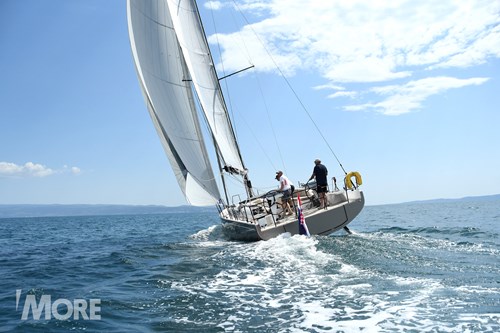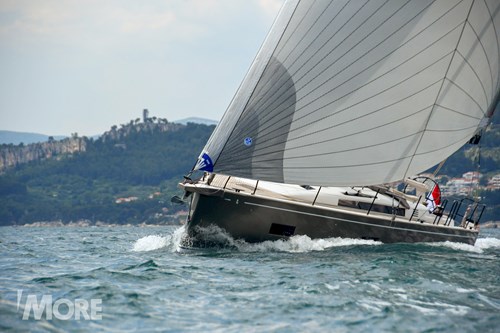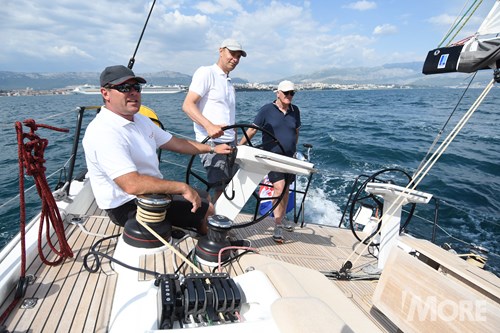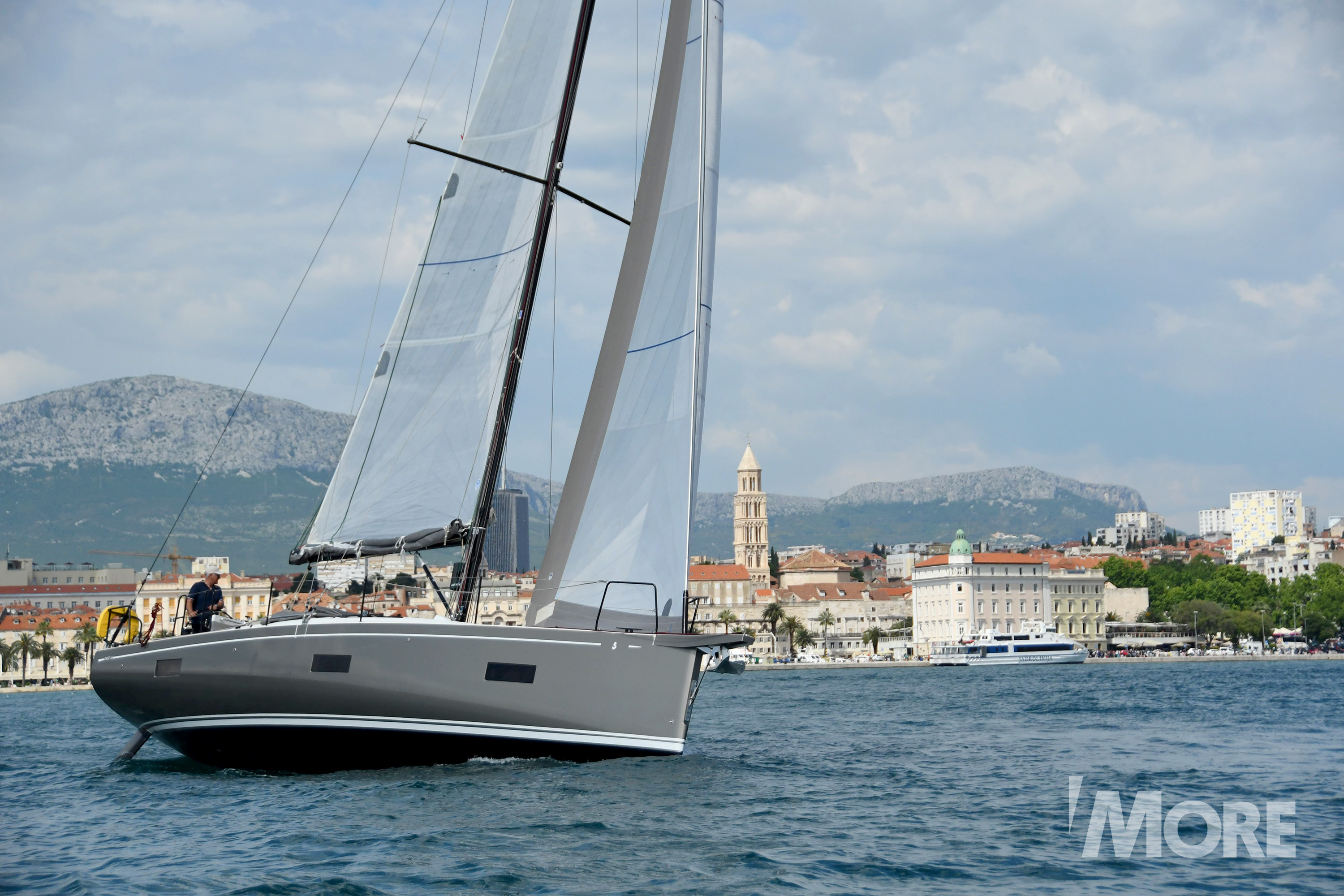Beneteau's oldest line has a cult status, and among industrial sailboats it represents a good price-quality ratio. We sailed her in typical summer Adriatic conditions
We can't say much about the First line without sailors already knowing it for a long time. It is the oldest and recognizable line of sailboats from the French shipyard Beneteau, which has been built since 1977. They stand out for their good performance and maritime capabilities, they are suitable for family cruising and club regattas. So far, over 25 thousand examples and a total of 70 models of sailboats have been built under that name.
It is probably impossible to find a marina in the Mediterranean without at least one First moored there.
Today, the brand offers 6 models from 14 to 53 feet and they could be divided into 4 categories, from small sports 14 feet boat without a cabin, then 24-foot day sailboats, through 27- and 36-foot gliding cruisers, to performance cruisers of 44 and 53 feet, which fall under the broader term of yachts and are suitable for long family cruises, as well as competitive club regattas.
First 44 was premiered by the Beneteau shipyard last fall in Cannes, and this is exactly the sailboat with serial number 001. The naval architecture was done by the Biscontini Yacht Design studio, while the exterior and interior design was done by Lorenzo Argento and it is being built in two versions. The equipment of the first version is more oriented for cruising, with an emphasis on comfort and is called simply First 44, while the second is more sportily equipped and is called First 44 Performance. The main differences are in the depth and type of keel, the weight and material of the bulb, then in the height and material of the mast, and in the deck covering with teak or gelcoat, i.e. the cockpit equipment with 4 or 6 winches, with and without mainsail sheet sliders, etc.
The performance version also offers the option of water ballast tanks of 300 liters on each side. It's not much, but when we're in a regatta, every half knot of speed is worth it...

MODERN DESIGN, CARBON MAST
Since our test example was built for presentation at the fair, it has mixed equipment, so the keel is shorter and the deck is teak, and in the cockpit there are four winches, three of which are electric, but the mast is higher and made of carbon. Both versions are offered as standard with a large integrated garden. The sailboat is modern, with the mast moved as far as possible to the stern, in order to provide as large a surface as possible for the flying sails.
The line of the boat is very elegant, modern, with wide sides, and a wide stern, rounded from the waterline to the upper part of the hull. The profile of the cabin roof is low, and in general the deck is very simply designed with long, gentle lines, so visibility is excellent from any angle. The deck on the bow is accessible and comfortable for preparing sails, and since it is flat, it is suitable for enjoying the sun while anchoring, and folding chairs could also be placed there for romantic occasions.
The side passages are wide and unobstructed along the entire length of the hull. Walkability is an important item on a boat because it guarantees a quick reaction, i.e. safe navigation. The cockpit is modern, with elegant rounded lines without sharp elements of the bench and around the entrance, and this is always a sought-after feature so that the ropes do not get stuck, it is harder to get stuck and it looks good. The benches are ergonomically designed and comfortable, especially with cushions, and considering the ease of handling the sailboat, it is to be expected that the crew, including the skipper, will mostly be reclining deep in the back of the benches during the cruise.

FUNCTIONALITY OF THE SPACE
The horizon is clearly visible from the cockpit, even when the sprayhood with bimini is raised, thanks to the high transparent windshield. There is a good and clear view of the instruments mounted on the mast under the boom, and all the controls for correcting the direction using one of as many as three autopilot control devices in the outer section are within reach.
From the position of the skipper, the possibilities are such that the sailboat can be steered by two without difficulty, and more resourceful sailors will simply steer it alone. On the pedestals of the rudder wheels are all navigation devices. Our example is equipped with large Garmin chart-plotters on both sides, a bow thruster control device, a separate Raymarine autopilot device, a compass, buttons for controlling navigation and ambient lights, a horn, a transom lift and provided places for buttons for the water ballast system that we did not had available.
Right in front of the rudder stand on each side are one electric winch and one manual winch, to which all the ropes with stoppers are threaded and from there the skipper has complete control over the boat. In the original, this "cruising" version of the deck equipment comes with a fixed position of the bulkhead in the middle of the cockpit, between the two rudder wheels, which is not the smartest solution. Fortunately, we had installed a large slider which, in addition to allowing better control of the sail, provides better passage in the cockpit.
The First 44 has an interesting solution of a side bench for the skipper on both sides, which is well positioned for seating in several ways. The area around the skipper has a high solid aluminum fence in the corners of the stern and in the middle, so during sailing one feels safe and has a place to lean on. There are inclined steps in the floor, ideal for horizontal standing when the sailboat is tilted. Below the cockpit at the stern is a large garage space, which is accessed from above through the large cockpit opening or through the width opening when the stern platform is lowered. An inflated tender, a small motor and other sea toys fit inside. The platform is perfect for enjoying the joys of summer. Thanks to the large solid stairs that open together with the platform, there is excellent communication with the coast when staying in the marina.
FOR LONG SAILING
The entrance to the cabin is wide and has a solid stainless steel handrail on the left side, which is an important thing for a quick reaction considering that it is a sailboat with a high interior ceiling, so from the cockpit to the floor we have to walk six steps. The interior is very spacious thanks to the 4.25 meter width in the middle of the hull. The living room is dominated by a large L-shaped kitchen and a large dining table on the left side of the space, with two large benches. Since the mast is moved towards the stern, it is located next to the middle of the table, which is not very common, and here we also see that when designing the sailboat concept, the emphasis was on sailing, without compromise at the expense of the interior.
The most important thing is that it doesn't get in the way, and since we're on a sailboat, it's nice to see the key ship elements. Opposite the table, on the right side, there is a large bench suitable for resting during the day, which can also be expanded by raising the backrest, and be suitable for resting the skipper. From the lie-down position, there is a good view of another large Garmin MFD, above the skipper's desk with all the necessary navigation devices, chart tray and key power switches within easy reach.
The kitchen is fully equipped for a long stay and the preparation of complex meals, and there is plenty of space in the elements under the sink and in the cabinets for storing food, dishes and utensils. Opposite the kitchen is a spacious bathroom with a separate shower cabin and a large sink
THE SAILING BOAT HAS A WELL-FITTED HULL, SAILS WELL AND YOU CAN FEEL EVERY INTENT OF HER AT THE RUDDER
The interior ambience of our model is very pleasant, with warm shades of wood. All elements and the floor are made of waterproof plywood with veneer technology. The floor is rougher, and the cabinet surfaces are covered with fine teak veneer, with solid wood edges. Which means that the floor and some parts of the elements will probably wear out quickly due to intensive use, for example in charter, but this is today's standard and such a covering is relatively easy to change when the time comes.The aft cabins are equipped as standard, with enough real comfort for a longer stay of two people. The engine room is also laid out as standard, with ample access under the entrance steps and through several hatches on each side through the aft cabins. It does not come with a light installed as standard, which is useful and easy to install, and besides, it looks tidy and easily accessible for the most common service jobs.

SAILING AND IMPRESSIONS
Our test sailboat was equipped with a mainsail, a roll genoa and a Code 0. We sailed in conditions of a moderate mistral at a speed of about 12 knots, a wind typical for summer periods on the Adriatic. Along the coast, where the mistral weakened to 7 knots, the speed was still above 5 knots. In a sharp orca with 13 knots aparent and against the current in front of the Port of Split, we kept 7.5 knots. As a rule, we sailed mezzanines at the speed of the wind, while at half-stern, with Code 0, the speed was about 8.5 knots.
Sailing on a motor is pleasant, with almost no noise and no vibrations. Inside is a Yanmar 4JH57, with an electronic steering handle, which on a sailboat has its drawbacks, for example, it cannot be put into gear when the engine is off, so the propeller can be heard while sailing. Fortunately, due to the modern fenders made of synthetic materials, this sound is drowned out by the vibrations from the wind flow in the hull, which gives the boat a real "sailing" feel. The boat is equipped with a bow thruster to assist in docking. Since it has a two-leaf rudder system, which is an advantage in sailing, it has its drawbacks when docking, but these are things that the owner of this type of boat has to get used to, and in combination with the thruster, he can perform the desired maneuvers in the narrow spaces of the marina. On the tiller, the feeling of steering is extremely sensitive, precise, and anyone who wants to drive out every tenth of a knot will be able to feel it in their hand, which is an exciting feeling. When released, the glider immediately finds its way and gives an indication of what else could be adjusted. Likewise, by pressing the autopilot button, the sailboat sovereignly endures waves, drifts, and nothing dramatic happens.
Hrvoje Modrić and Emil Tomašević from the charter company Ultra Sailing were with us on the test. Emil is a fan of Beneteau sailboats and their long-time representative, director of Ultra, and above all, a successful Croatian sailor. You had the opportunity to read his articles on sailing in Mor 20 years ago, and you may have also read his book Sailing Manual... Emil's experience, skills and knowledge about sailing are undeniable. But despite being biased, we asked him to try to summarize his impressions of the First 44.
THE RELATION OF INVESTED AND OBTAINED
"When I see a horse on something that says First, I have a feeling that it's good. Because the relationship between the value and the received is in favor of the received. It has a good design and a good price compared to boats that have the same quality and cost more. First 44 is a true example of that and I loved it from the first moment. This boat has a little 'too much' equipment - teak deck, air conditioning, heating, extra batteries and all possible equipment, plus a carbon mast and a standard keel. So it's Performance, but not the real one. It sails very nicely, it needs 5, 6, 7 knots of wind, after that it reaches very nice speeds. I believe that if they measured him, he would have success in regattas. As a family cruiser, I think this is what Beneteau knows how to do. In the 40- to 50-foot category, you'll be hard-pressed to find such good value for what you get. There are things that could have been better, but there are also things that are better than I expected. Beneteau knows how to do everything, the only question is whether it pays for them. With the First line, they invest a little more because it is a brand for their image, not a brand that brings money. It has a great tradition and I think First 44 is really a real First."
And we will agree with Emil. The design, performance and feeling of sailing and staying on the boat are without complaint, while the materials used in the interior are a bit cheaper, but this is really felt in the final price of the boat. Also, the sailboat seems easy to maintain, which is an important item, especially if it is on charter. It is easy to manage, you can sail as a couple and feel calm and safe.
FIRST 44:
Length O.A: 14,15 m
Hull Lenght: 13,18 m
Water line: 12,82 m
Beam: 4,25 m
Balast (standard): 3300 kg
Displacement: 10.660 kg
Draft (standard): 2,15 m
Arhitect: Biscontini Yacht Design
Design: Lorenzo Argento
Year of model 2022.
Fuel tank 200 l
Water tank 370 l
Engine: 4JH57 CR SD 57 KS
Carbon mast
Main Sail 61 m2
Genova 60 m2
Code 0 105 m2
Crew: Ekipa Mora, Emil Tomašević i Hrvoje Modrić
Wrote: Teo Marević
Filmed by: Teo Marević i Marin Srzić
TEXT FROM MORE MAGAZIN





